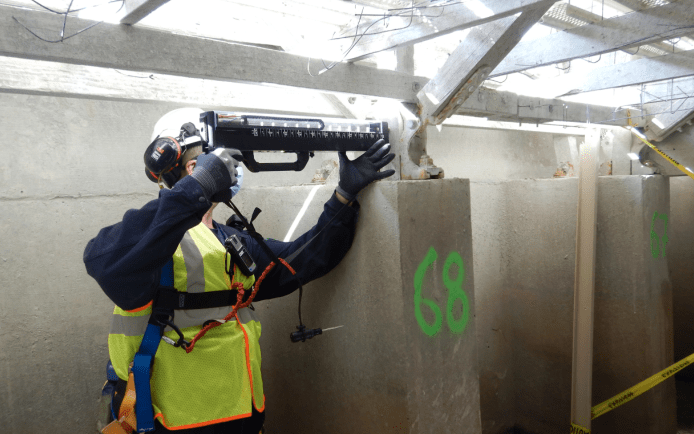By Matthew Wooden, Associate Structural Engineer, Brindley Engineering
Welcome to Part 9 of Brindley Engineering’s 10-part series on Infrastructure Reliability. In Part 8 we explored the topic of fire proofing and fire safety. In Part 7 we explored Structural Reliability, In Part 6 we talked about Tank Reliability and ASTs. In Part 5 we explored Piping and CUIs. Part 4 we wrote about level instrumentation. In Part 3 we explored electrical reliability. In Part 2 you read about process utilities, and in Part 1 we wrote about the risk of neglective critical infrastructure and protecting what matters. In part 9, we will discuss Cooling Towers.
Importance of Reliability Assessments
Cooling tower reliability is critical in maintaining normal unit operations in petrochemical refineries and chemical plants. Performing reliability assessments on cooling tower structures provides the Owner with important data on degradation rates, end of service life projections, local deficiencies, and overall condition of the tower. The structural and mechanical deficiencies noted during a reliability assessment allow maintenance efforts to be planned and prioritized based on the level of process risk. Executing repairs on a cooling tower while it remains in service minimizes the impact on production and profit, however, planning these repairs has several engineering and operational challenges.
The Challenge
Brindley Engineering (BE) provided engineering and inspection services to an ethylene producing chemical plant to support the ongoing rebuild of an existing timber cooling tower to a fully FRP structure. The challenge brought to BE was to determine the feasibility of rebuilding the cells while eliminating the need for a full outage of the tower, which would reduce costs and improve construction efficiency. However, this would require the primary inlet header distribution piping to remain operating and fully shored while the structure supporting it was being replaced.

BE the Solution
BE utilized data from a pipe stress analysis of the header pipe to determine the required shoring loads that would be re-distributed to the structure. A structural analysis model was then used to study the utilization of the adjacent timber members to evaluate if the structure could adequately support the additional weight of the header pipe based on the shoring configuration provided by the Owner. Reliability data (e.g., remaining column cross section) from recent inspections was also incorporated into the FEA modeling to reflect current conditions due to degradation and age of the structure.

BE the Result
The feasibility study was performed on the header pipe shoring through multiple iterations to explore all possibilities and alternate shoring configurations. It was determined that by providing temporary shoring and re-distributing the header load, the structural bents of the cell could be fully rebuilt in a phased approach while operating the remaining cells at full capacity. Improving the construction efficiency of cooling tower maintenance lowers cost and cell outage duration, allowing the overall reliability of the structure to be improved in an accelerated timeframe.
Performing reliability assessments on cooling tower structures is a cost-effective strategy for monitoring the reliability of and maintaining the structure. The data collected during the assessments play key roles in determining repair strategies and maintenance scopes for refining and chemical facilities. Cooling towers do not directly generate profit for Owners, however, neglecting maintenance on cooling towers can lead to structural collapse and reduced service life resulting in more costly repairs and loss production time across the facility.




More From This Series:
- Part 1: Infrastructure Reliability – Protecting What Matters
- Part 2: Utilities – Water quality and the effects of impurities on on-stream operability
- Part 4: Instrumentation – Level instrumentation and its effects on reliable operation
- Part 5: Piping – Loss of primary containment caused by poor pipe routing
- Part 6: Tanks – Settling, buckling, and fitness for service assessments
- Part 7: Structures – Structural degradation and the risk of systemic collapse
- Part 8: Fireproofing – Fireproofing degradation, fire safety and corrosion of underlying steel
- Part 10: Project Controls – Understanding the big picture in real-time


0 Comments